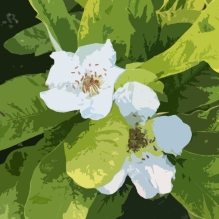


It’s been raining for hours as I write. The dull grey skies feel quite oppressive, but looking out on a bunch of daffodils growing across the road in a neighbour’s garden cheers me up no end. We’re used to seeing yellow daffodils along the verges around here. More and more people are planting them along the road side in front of their houses and even fields; planted en mass, they are a lovely and add interest to country roads and the otherwise dull roundabouts.
Apart from the big ubiquitous plain yellow large flowered daffodils (Narcissus) there’s quite a variety of forms that you may not know about. For a start, there are dainty forms that usually flower early like “February Gold” and “Tete a Tete” And these are best grown in groups at the front of borders or in short grass.
Not all daffodils are yellow. I particularly like the white and pale orange combination such as those in the photo above. That’s a variety called ‘Pensioner’.

Then, there are a number of what are called “double varieties” where the tube shape or corona has been replaced by multiple petals. Sometimes the outer petals also consists of more than one whorl. These can be yellow or a combination of white, yellow and orange. I am not a great fan of the very bright ones but I know many people like them.

My favourite daffodils are the multi headed ones like ‘Thalia’ or ‘Rippling Water’. They are usually the last to flower in our garden, around mid-April. But I really love their more delicate looking flowers and they make a superb display if grown covering a big area. I also like to plant them in a large container with tulips that flower at the same time.

So, these are some varieties you might like to look out for in the late summer – autumn, when they become available from nurseries and garden centres.


